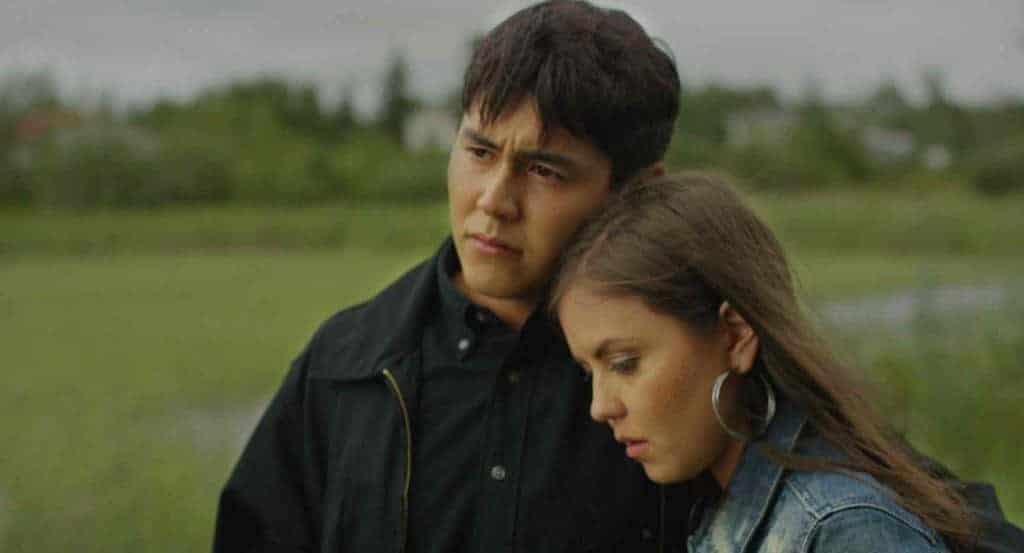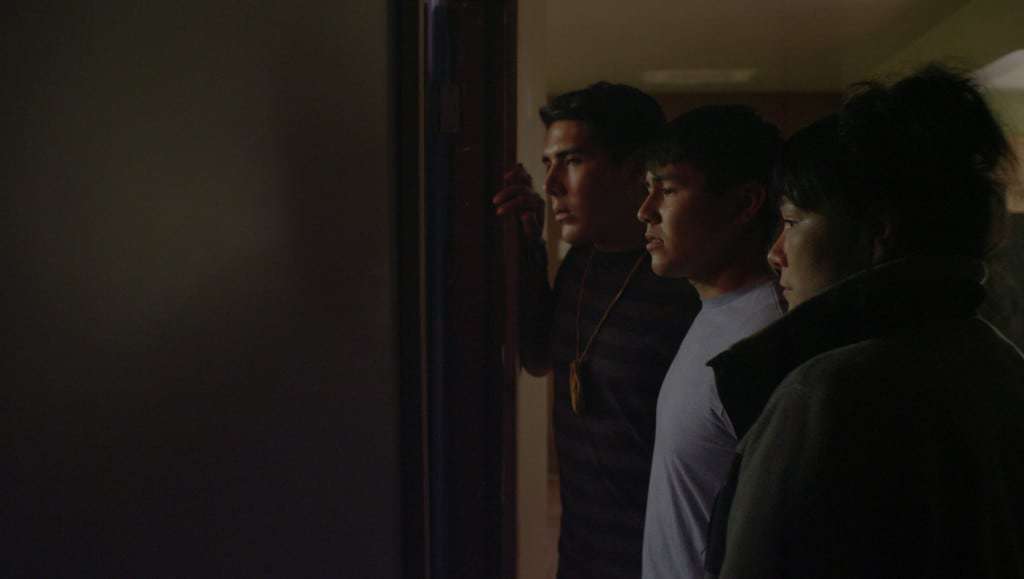Writer-director Adam Garnet Jones discusses his debut film Fire Song the first Canadian film about a Two-Spirited character, a Queer Native. It opens in Toronto on May 13.
Read our review of the film here. The film opens in Toronto on May 13 at Carlton Cinemas, and is set to screen until at least May 19. For more information or to watch the trailer, click here.

At the Toronto International Film Festival, writer-director Adam Garnet Jones premiered Fire Song, the first Canadian film about a Two-Spirited character, a Queer Native. As a Queer Native himself, Garnet Jones has laboured over this story for five years, from writing the script to finally producing the film. The film deals with suicide, grief, and the internal conflicts of closeted Two-Spirited teenager Shane living on a Northern Ontario reserve. He’s about to graduate and contemplating leaving his Northern Ontario reserve for university: the big city offers more opportunities and a more open, accepting environment, but it means leaving everything he knows, including his culture and land.
“At first, I was writing a film about a feeling more than anything,” recalled Garnet Jones. “I had a tone in mind more than a story at first.” “I wanted to write a film that took place in a community after a suicide in that community,” he explained. He sought “to capture that feeling of all of these people waiting for the other shoe to drop — the nervousness that gets mixed up with grief when a young person dies. There’s this fear that it’ll be the first in a string or a cluster of suicides. So that’s where I started writing from, and then the rest of the story really came from that.”
The first Pride Parade at any reserve in Canada was just at Six Nations [in August 2015].
Two-spirited people are becoming more accepted within many First Nations communities. Garnet Jones noted that “The first Pride Parade at any reserve in Canada was just at Six Nations a month ago.” But “that community, it’s closer to Toronto; it’s quite urban; it’s much more affluent than a lot of reserves; and it’s huge just in terms of actual number of population. People are able to be a little bit more open there, whereas in smaller, more remote communities, communities that have had a stronger influence from the church, tend to be a lot more hostile.”
Garnet Jones was particularly happy that “there’s so many two-spirited people in front of the camera. I think four actors in the film are all queer of some kind. Like Ma-Nee [Chacaby] she played Evie — is actually a really well-known two-spirited elder. She’s one of the few really visible Two-Spirited people in the community. So it’s neat for me that she is in the film, and that she ended up playing a character that’s so different from herself.”
“In one of the places where we shot, Wabigoon Lake,” Garnet Jones said, “Donna Chief, who played one of the police officers toward the end of the film — she is a well-known queer aboriginal woman who’s from that community and lives with her wife in that community and has for a long time. It is a very, very small place and pretty far removed from anywhere else. But they are a very integrated part of that community and very open. So it’s one of those things where you just never know how it’s going to go. Because there is still that threat of danger and of violence but people can still surprise you.”
I thought it was really important to cast as many people from Northern Ontario as we could. We were shooting up there. We wanted to make the film feel as much like it’s really part of that place as possible
Garnet Jones’s first casting call took place in a cube van in the back of a parking lot. “We did a bunch of casting sessions before we even had the film funded,” Garnet Jones recalled, so “at our first casting sessions we went to the first pow-wow of the year in Thunder Bay and handed out fliers to all of these young people, basically telling them ‘Come to the parking lot tomorrow and audition to this movie in the back of our van.’ And, you know, you try to make that not sound creepy, but it’s pretty difficult.”

Because he was working with so many non-actors, Garnet Jones organized a “week-long intensive acting-on-camera training session with the actor Glen Gould” for his cast. In addition to acting skills, Garnet Jones was looking for people who could show up on time, stay focused, and be committed. As Garnet Jones explained, because “These are people who five minutes ago had never thought about being an actor and suddenly you’re offering them a part in a feature film, and they might not understand the responsibility of that.”
Garnet Jones felt the camera should always be “expressive of Shane’s emotional state.” This impacted the camera setup he chose for each scene: “whether we were going to be handheld, or whether we were going to be on sticks.” Because the film explores how Shane’s self-expression is being stifled on the reserve, Garnet Jones wanted the audience to “really feel the closeness of the interiors and for the interior spaces to feel kind of claustrophobic.”
He shot the interiors tightly so that when he moved to the landscapes outdoors, the space would “open up and expand” to “show the beauty of the place that they’re in. It was important to me that it feel like a place where they would want to live, and where they would want to stay, and a place that they would feel connected to.” Garnet Jones continued, “The landscape and the openness of that landscape [was] almost a metaphor for this whole wide world that’s waiting for them out there, just beyond what they can see. I wanted to keep going forth between this open landscape and this beautiful location and these tight, cramped interiors.”
Throughout the film, Toronto looms large as a mecca, a place to dream about escaping to from those cramped interiors. “I think anybody who’s ever grown up in a small place and not wanted to be there — you often dream of going somewhere else,” said Garnet Jones. “When I was in high school, it was Vancouver, because that was the closest big city. Those places — when you’re not in them, and you want to be there, take on this magical quality.”
As Shane’s community is deeply homophobic, moving to the very liberal Toronto also means escaping to a place where he can be himself without fear of violence. “Because it’s the biggest city in the country and not so far south, it feels both really close and like a world away,” said Garnet Jones. “It can have that kind of magical power and magical draw, but just getting there is like taking this enormous leap of faith into this completely unknown world.” For Shane, leaving for Toronto may be the one way to avoid getting trapped in that cycle of suicide himself.
I really do feel like if I hadn’t found that place, if I hadn’t started doing that, I wouldn’t be alive today.
Garnet Jones understands what it means to take that leap. Garnet Jones got his start in filmmaking when he attended the Gulf Islands Film and Television School, on Galiano Island, in the nineties, when filmmaking equipment was hard to come by. “I did all kinds of odd jobs and did everything I could to save up money to go to this place. I went there and made my first film, and it completely changed my life. I felt like, for the first time, my voice was being heard, and that maybe it was something in this world that I could do.” He paused. “I really do feel like if I hadn’t found that place, if I hadn’t started doing that, I wouldn’t be alive today.”
Like Shane, Garnet Jones also saw Toronto as a mecca, but for much more practical reasons: the Canadian film industry is concentrated there. “I was watching CBC at night, and I realised that, at that time, everything that was Canadian looked like it was being made in Toronto. There’s lots of stuff that was shooting in Vancouver, but it was all American. I had this Eureka moment when I realised, ‘Oh, everything that’s Canadian is being made in Toronto. I guess I have to go to school in Toronto.’ “
Garnet Jones was able to secure a place at Ryerson to study filmmaking, and he’s been in Toronto ever since. “For me personally,” Garnet Jones continued, “I feel like I never stopped searching for that [sense of community]. Wherever I go, I’m always looking for where I’m going to find my community, where I’m going to find my people”
Fire Song had its world premiere at the Toronto International Film Festival in September. This article was originally published on Oct. 16, 2015 and has been re-published for the film’s Canadian release.
Read more: Review: Fire Song presents an authentic queer, First Nations narrative >>
Read more: Canadian director Stephen Dunn talks Closet Monster and internalized homophobia >>

